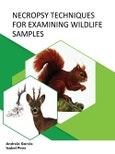In this handbook, the authors provide a practical, easily accessible guide of necropsy techniques for examining wildlife. Chapters introduce the reader to the value of necropsy in studying wildlife in general, sample collection methods, cadaveric phenomena and necropsy techniques for a variety of organisms ranging from invertebrates to mammals. The book addresses some of the peculiar characteristics of veterinary autopsy specific to different types of specimens. The goal of this book is to equip the reader with the information necessary to conduct a forensic examination in order to reach a conclusive diagnosis of an animal’s death, while also understanding it in an ecological context.
Necropsy Techniques for Examining Wildlife Samples is intended as an essential handbook for students and professionals of biology, zoology and veterinary medicine as well as professionals, who work in natural parks, wildlife rehabilitation centers and biological or zoological parks as conservationists, researchers or animal handlers.
Necropsy Techniques for Examining Wildlife Samples is intended as an essential handbook for students and professionals of biology, zoology and veterinary medicine as well as professionals, who work in natural parks, wildlife rehabilitation centers and biological or zoological parks as conservationists, researchers or animal handlers.
Table of Contents
Chapter 1 Necropsy in Wildlife
- The Importance of Post-Mortem Examination in the Wildlife
- Forensic Wildlife Necropsy
- Risks Associated with Wildlife Necropsy
- Ante-Mortem History
- Natural Death Vs. Euthanasia
- Amphibians and Reptiles
- Invertebrates
- Fish and Aquatic Invertebrates
- Terrestrial Mammals
- Birds
- Material and Equipment
- The Necropsy Report
- References
Chapter 2 Sample Collection
- Sampling
- Histology
- Microbiology
- Parasitology
- Genetic
- Toxicology
- Conclusions
- References
Chapter 3 Cadaveric Phenomenons
- Post-Mortem Changes
- The Abiotic Mediate Or Consecutive Phenomena
- Biotic Cadaveric Phenomena
- References
Chapter 4 Necropsy in Wild Birds
- General Considerations
- External Exam
- Internal Exam
- Endocrine System and Hematopoietic System
- Cardiovascular System
- Digestive System and Annexed Glands
- Respiratory System
- Urinary System
- Genital System
- Nervous System
- Locomotive System
- References
Chapter 5 Necropsy in Wild Mammals
- General Considerations
- External Examination
- Internal Exam
- Cardiovascular System
- Respiratory System
- Digestive System and Annexed Glands
- Endocrine and Hematopoietic System
- Urinary System
- Genital System
- Nervous System
- Musculoskeletal System
- References
Chapter 6 Necropsy in Reptiles
- General Considerations
- Suborder Ophidia
- General Considerations Before the Necropsy
- External Exam
- Internal Exam
- Suborder Sauria
- General Considerations Before the Necropsy
- External Exam
- Internal Exam
- Order Crocodylia
- General Considerations Before the Necropsy
- External Exam
- Internal Exam
- Order Testudinata
- General Considerations Before the Necropsy
- External Exam
- Internal Exam
- References
Chapter 7 Necropsy in Amphibians
- General Considerations
- External Exam
- Internal Exam
- References
Chapter 8 Necropsy in Invertebrates
- General Considerations
- External Exam
- Internal Exam
- References
Chapter 9 Necropsy in Fish
- General Considerations
- External Exam
- Internal Exam
- References
Chapter 10 Necropsy in Eggs
- General Considerations
- External Exam
- Internal Exam
- References
- Subject Index
Author
- Andreia Garcês
- Isabel Pires








